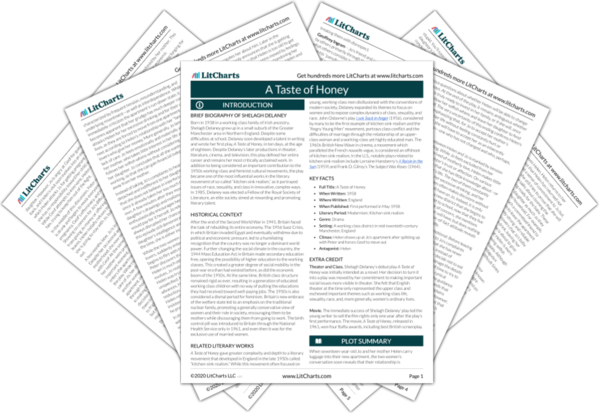Welcome to the LitCharts study guide on Shelagh Delaney's A Taste of Honey. Created by the original team behind SparkNotes, LitCharts are the world's best literature guides.
A Taste of Honey: Introduction
A Taste of Honey: Plot Summary
A Taste of Honey: Detailed Summary & Analysis
A Taste of Honey: Themes
A Taste of Honey: Quotes
A Taste of Honey: Characters
A Taste of Honey: Symbols
A Taste of Honey: Theme Wheel
Brief Biography of Shelagh Delaney

Historical Context of A Taste of Honey
Other Books Related to A Taste of Honey
- Full Title: A Taste of Honey
- When Written: 1958
- Where Written: England
- When Published: First performed in May 1958
- Literary Period: Modernism; Kitchen sink realism
- Genre: Drama
- Setting: A working-class district in mid-twentieth-century Manchester, England
- Climax: Helen shows up at Jo’s apartment after splitting up with Peter and forces Geof to move out
- Antagonist: Helen
Extra Credit for A Taste of Honey
Theater and Class. Shelagh Delaney’s debut play A Taste of Honey was initially intended as a novel. Her decision to turn it into a play was moved by her commitment to making important social issues more visible in theater. She felt that English theater at the time only represented the upper class and eschewed important themes such as working-class life, sexuality, race, and, more generally, women’s ordinary lives.
Movie. The immediate success of Shelagh Delaney’ play led the young writer to sell the film rights only one year after the play’s first performance. The movie, A Taste of Honey, released in 1961, won four Bafta awards, including best British screenplay.







